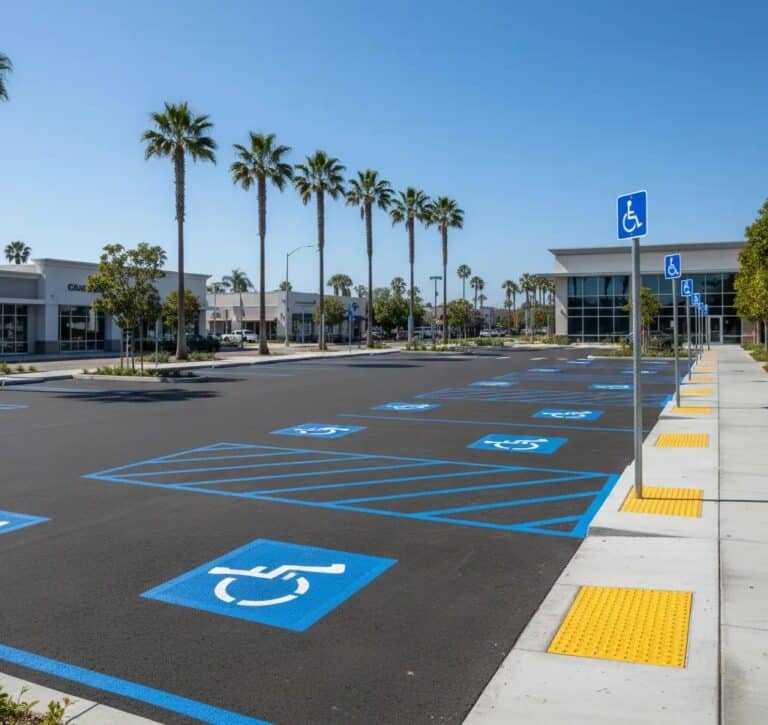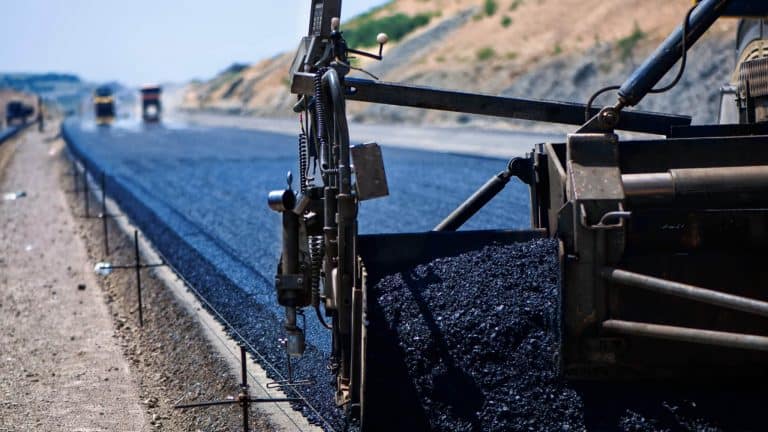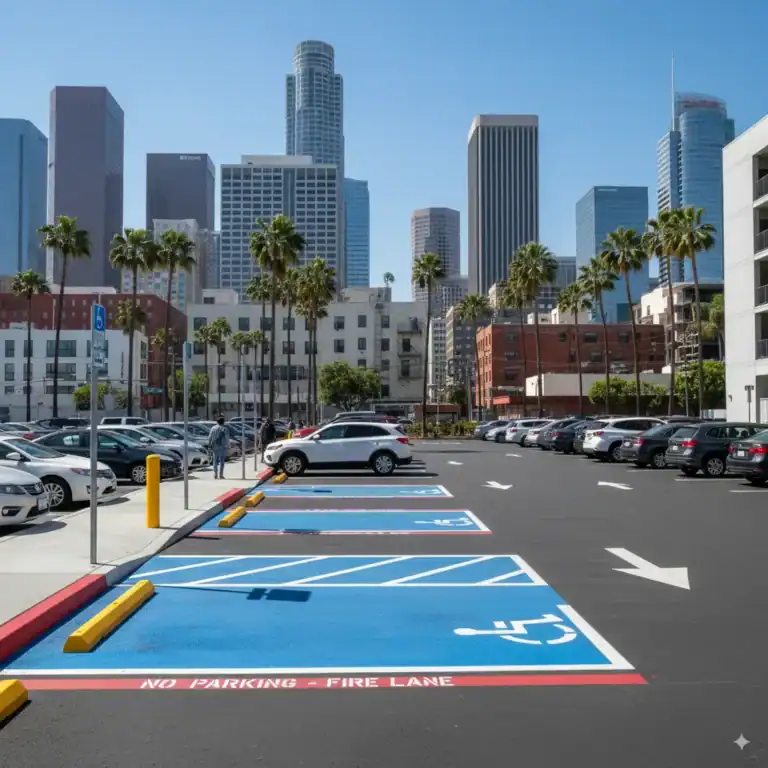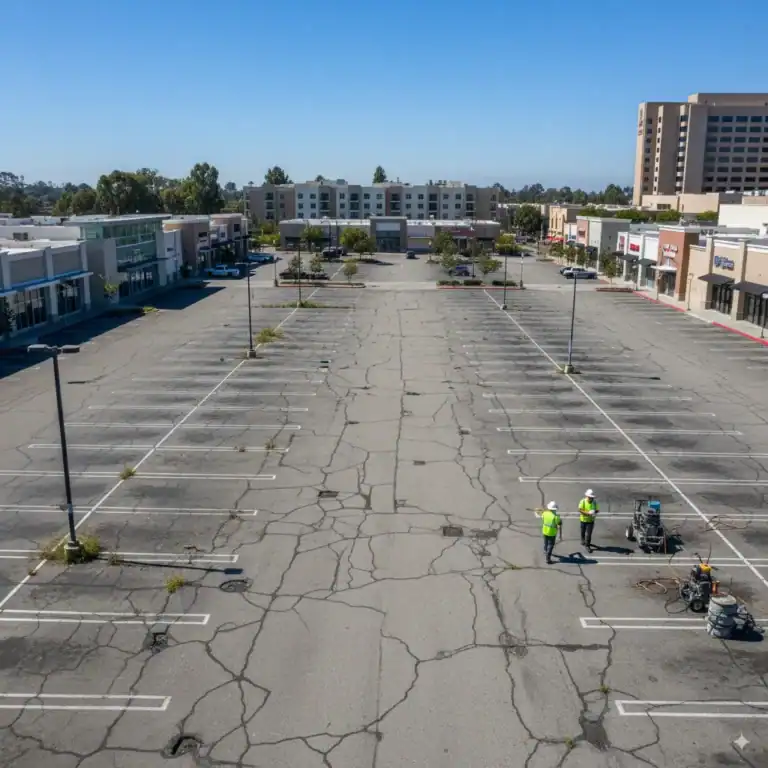Driving in Los Angeles tests even seasoned motorists. Roads like the 405 Freeway or Pacific Coast Highway face heavy traffic, shifting weather, and complex layouts. Fog or sun glare can reduce visibility, making clear road guidance vital. Highway striping in Los Angeles uses lines, symbols, and barriers to direct vehicles and pedestrians, ensuring safe navigation. Originating in the 1920s with California’s early highways, striping has evolved under the Manual on Uniform Traffic Control Devices (MUTCD) and Caltrans standards. In 2025, Los Angeles County reports 788 traffic deaths annually, with faded markings linked to lane drifts and collisions, especially on busy routes like the I-10, handling 400,000 vehicles daily. This guide covers how striping improves safety, meets regulations, manages costs, and selects trusted contractors. It offers practical advice for property managers, HOAs, schools, and public agencies overseeing roads, parking lots, or commercial entrances.
By the end of this article, you’ll know how to:
- Identify types of striping materials and their uses in urban settings.
- Understand how markings reduce crash risks with Los Angeles examples.
- Apply MUTCD and Caltrans rules for compliant striping.
- Balance striping costs with long-term durability benefits.
- Choose reliable highway striping services for safe, compliant results.

What Is Highway Striping? Understanding the Basics
Highway striping in Los Angeles places visual guides on roads to regulate traffic and pedestrian flow. These include lane lines, stop bars, and symbols like arrows or words, standardized by the MUTCD and California’s version for clear recognition. Yellow lines separate opposing traffic, as seen on Sepulveda Boulevard, while white lines divide same-direction lanes, common on freeway merges. Local roads use 4–6-inch lines; state highways require 6 inches per Caltrans. Broken lines (10-foot dashes) allow passing, while solid lines prevent it. Double-yellow lines restrict crossing on divided roads, with gaps for turns, accommodating LA’s mix of narrow arterials and multi-lane freeways.
Caltrans uses “Elephant Tracks”—thick, closely spaced lines—in exit lanes to prompt early lane changes, reducing swerves on ramps like the 101 in Hollywood. HOV lanes feature double white lines with breaks for access, supporting shared rides. Shoulder lines, flared at exits, guide drivers in low visibility, such as coastal fog zones. Materials include water-based paints for temporary work zones, oil-based paints for moderate durability, and thermoplastics, heated to 400°F for a strong asphalt bond. Thermoplastics, mixed with glass beads, retain 70% reflectivity after two years, compared to paint’s 30%, ensuring visibility on routes like the 110 Harbor Freeway with 300,000 daily vehicles.
Preparation involves sweeping debris, filling cracks, and priming surfaces. Dry weather ensures proper curing, avoiding LA’s winter rains. For multi-lane highways, wider edge lines and rumble strips add tactile alerts. Symbols like stop bars (24 inches wide) and arrows (8–12 feet long) clarify intersections and turns. Bike lanes near Venice Beach use green buffers with white edges for cyclist safety. School zones use 12-inch zebra stripes to slow traffic by 5 mph on average.
Example: On the 10 Freeway in Culver City, double-yellow barriers stabilize weaves. Near Dodger Stadium, broken whites guide tailgaters into lots safely. These adaptations balance standardization with LA’s unique needs, from 4 million residents in 1970 to over 10 million today.
The Role of Highway Striping in Road Safety
Highway striping in Los Angeles reduces driver errors by clearly defining lanes and hazards. Reflective thermoplastics, with glass beads returning 80% of light, extend visibility on routes like the 5 Freeway through the Grapevine, cutting nighttime run-off-road crashes by 34% (FHWA, 2023). In 2025, LA County reported 375 pedestrian deaths, with 15% tied to faded crosswalks. Ladder-patterned crosswalks slow vehicles by 10–15 mph, aligning with Vision Zero’s zero-fatality goal, though 788 total deaths in 2025 show ongoing challenges.
Directional arrows on curves prevent unsafe maneuvers. Stop bars at signals reduce red-light violations on arterials like Wilshire Boulevard. HOV lines limit unauthorized access, easing congestion. Thermoplastics resist rain, unlike paints that blur in wet conditions. “Elephant Tracks” on 405 ramps provide 500-foot warnings, reducing sideswipes. Temporary orange tapes guide construction zones, as seen on I-15 repaves.
Case Study: A school crossing arterial had 12 minor collisions due to irregular lines. After applying 6-inch thermoplastic bars and arrows, incidents dropped to two, improving safety during pickups.
Quarterly checks monitor fade, with tires scuffing centers fastest. Rumble strips and signs enhance alerts. For hospitals or HOAs, clear striping ensures safe access, reducing liability. A 2025 Caltrans pilot on the 710 used enhanced beads, cutting night crashes by 18%. Santa Monica bike paths reduced pedestrian close calls by 22% with clear markings. CHP cites 500+ marking violations yearly; clear lines lower these by clarifying rules.
Regular maintenance prevents crashes. Contact ADA Striping for a free site assessment to ensure your markings meet safety standards.

Highway Striping and Compliance in Los Angeles
Highway striping in Los Angeles follows MUTCD and Caltrans standards for consistency. MUTCD specifies yellow for dividing traffic, white for same-direction lanes, and 150 millicandelas reflectivity for 500-foot visibility. California mandates 6-inch lines on state routes, 4–6 inches on locals, with flared shoulders for ramps. The CA MUTCD 2026 draft, effective January 2026, prioritizes eco-friendly thermoplastics and bike symbols, reducing microplastic shedding per ASTM D4060 standards.
ADA compliance requires accessible features, like 8-foot van spaces with blue hashes and 60-inch signs, ensuring 1:48 slopes for ramps. Violations risk $4,000 fines under the Unruh Act. Faded crosswalks or uneven lines disrupt wheelchair access, triggering complaints. Caltrans-approved contractors use certified materials (SSP 84-1 for paint, 84-2 for thermoplastics) with 20% bead density for reflectivity. Local codes require orange temporary lines in construction and green bike lane accents.
Example: A Santa Monica boulevard upgrade added 5-foot bike buffers and ADA-compliant ramp hashes, increasing cyclist use by 40% and resolving access issues.
Annual surveys verify 6-inch widths and 350–450°F thermoplastic fusion. LA County mandates runoff controls for paints to protect watersheds. For public entities, compliance avoids lawsuits and ensures equitable access. CASp inspections identify risks, like non-compliant shoulder slopes, ensuring holistic plans.
Costs and Durability: Making Smart Choices
Highway striping costs in Los Angeles depend on material, scope, and traffic volume. In 2025, paint costs $0.20–$1 per linear foot, thermoplastics $1–$2. A 1-mile, four-lane project (84,000 feet) ranges from $16,800–$84,000, plus 15–25% for prep like pressure washing ($0.10/foot). Symbols cost $50–$200 each. Emergency work adds 30%. Paints last 6–12 months on busy lanes, needing up to three restripes yearly for 20,000+ ADT routes. Thermoplastics last 3–5 years, up to 8 in low wear, saving 40% over five years (2021 study).
Example: A 2-mile arterial refresh cost $25,000 for thermoplastics versus $14,000 for paint (two repaints), saving 60% on labor long-term.
High traffic (50,000 ADT) reduces thermoplastic life to 2.5 years; UV fades paint 20% faster. Bundling with sealcoating saves 10%. Clear lines cut crashes by 20% (FHWA), offsetting $50,000 incident costs. Eco-mixes, at a 10% premium, match durability. Grants cover 50% for compliant upgrades. Quarterly scans trigger repaints at 50% fade. For schools, a $5,000 investment in durable lines avoided $20,000 in liability over three years.
Request a free quote from ADA Striping for cost-effective, durable striping.
Why Choose ADA Striping for Highway Striping? We Put Your Needs First
When it comes to highway striping in Los Angeles, precision, compliance, and durability are essential. ADA Striping combines decades of experience with certified expertise to deliver safe, long-lasting, and visually clear road markings that protect drivers and pedestrians alike.
- Decades of Expertise: 40+ years delivering precise, durable highway striping across Los Angeles freeways and arterials.
- Certified & Compliant: CASp-certified team ensures full ADA, Caltrans, and MUTCD compliance, avoiding costly fines.
- Long-Lasting Materials: Thermoplastic and epoxy markings withstand heavy traffic, sun, and rain for 3–5 years.
- Safety-First Solutions: Reflective beads and raised-profile lines enhance visibility, reducing accidents and lane drift.
- Comprehensive Service: From planning and prep to application and inspection, we manage every step efficiently.
- Trusted Results: Schools, HOAs, hospitals, and government agencies rely on us for safer, compliant roads.
- Rapid Response: 24/7 support for emergencies keeps your roadways safe and traffic flowing smoothly.

Partnering with ADA Striping ensures your roads are safe, compliant, and built to last. Our expert team provides tailored solutions that save time, reduce liability, and maintain traffic flow, giving you peace of mind on every project.
Conclusion
Highway striping in Los Angeles ensures safe navigation across freeways, arterials, and local roads. Thermoplastics and clear patterns reduce 788 annual traffic deaths (2025) by improving visibility and flow. Compliance with MUTCD, Caltrans, and ADA standards prevents $4,000 fines and ensures accessibility. Durable materials balance costs with long-term savings, cutting crash risks by 20%. Partner with ADA Striping for expert, compliant solutions tailored to your needs.
Take Action Now: Request a free CASp inspection quote to ensure your Los Angeles highways meet safety and compliance standards. Call (714) 500-7901 or submit an online form today.






